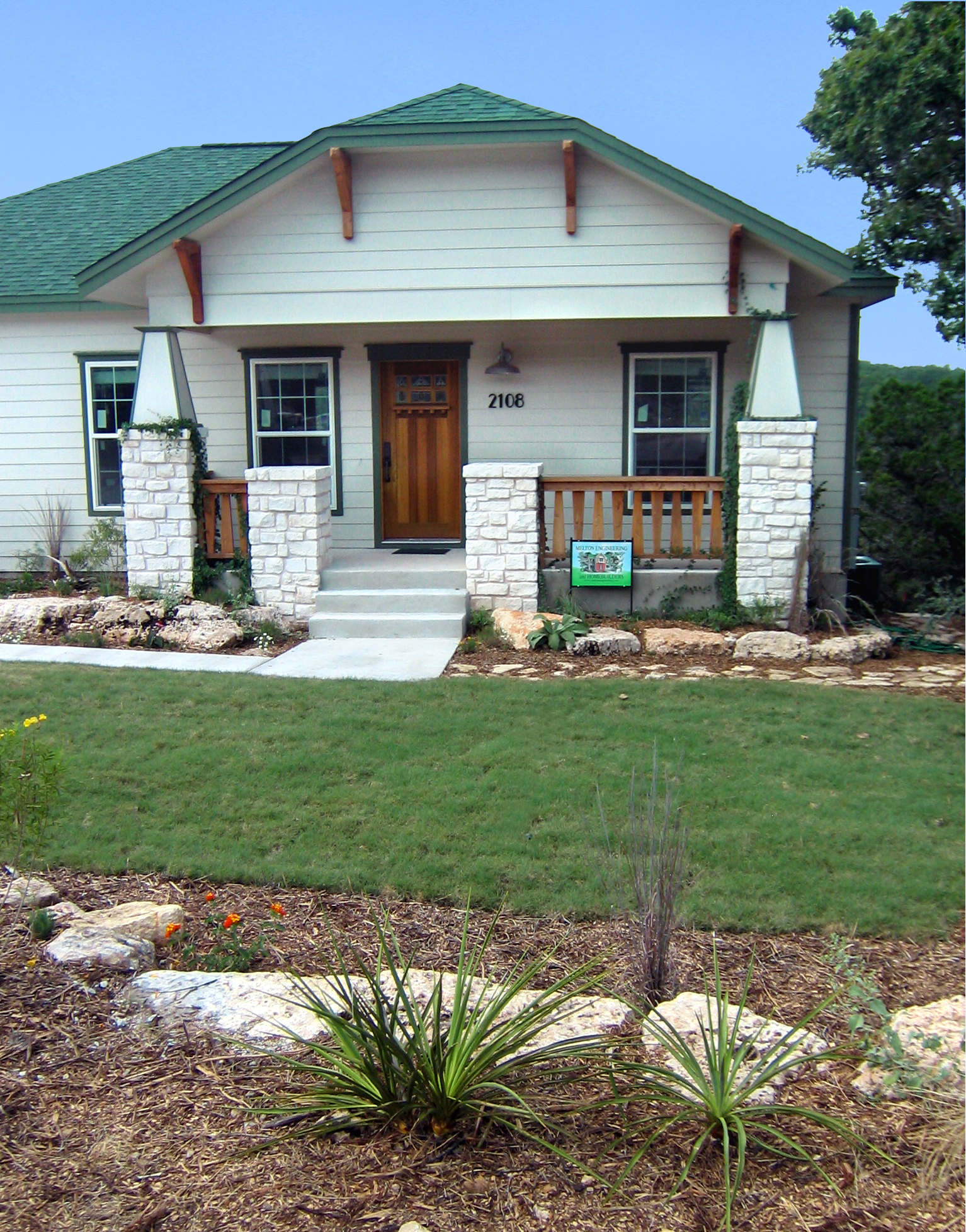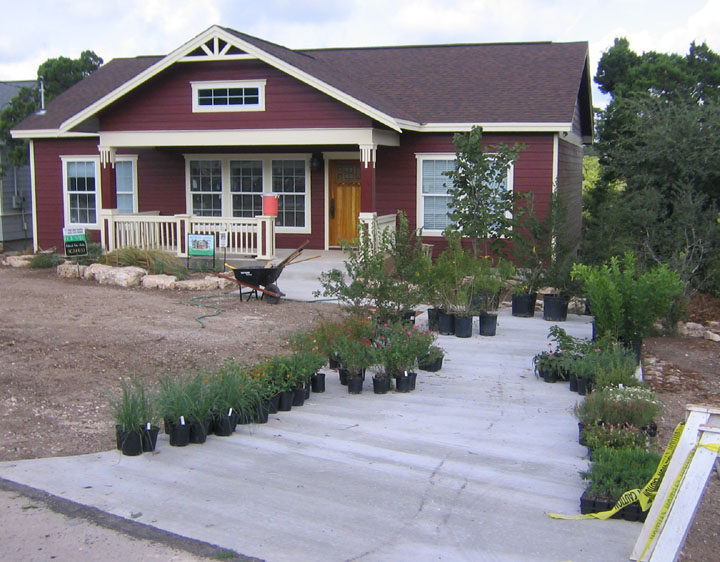

Early Maintenance
The Indian Creek Homes landscapes can be maintained as no mow ecosystems. This doesn't mean you can't mow the buffalo grass, or the native grasses in the back yards, or that the grasses will never need mowing. It means that typically, the way that the landscapes were designed, mowing will be required only once a year to maybe never, depending on the "look" that the individual gardener requires.
Buffalo Grass
Buffalo grass is naturally 4 to 6 inches tall and has a
fluffy flowing character that brings the wild qualities of the natural
environment into the landscape. Fertilizer will probably never, or only
occasionally be required. Fertilizer will enhance the growth rate and
deepen the color of your buffalo grass, and help develop a thicker turf to aid
in the prevention of weed growth, but the local soil used in these landscapes,
along with preventative hand weeding using good weeding technique is likely to
meet your expectations for a natural lawn.

Buffalo grass is drought tolerant, which means that during dry periods without artificial watering, the grass will brown off until adequate moisture returns to the soil. After rainfall or watering, the grass will quickly green up and continue growing. This cycle does no harm to the grass and conserves water. But you may (or not) want to water a few times a year to keep the grass green in places where the wastewater system irrigation does not allow for sufficient soil moisture. These homes have wastewater irrigation as a highly efficient wastewater disposal method in most of the front and back yards within 25 to 35 feet of the home foundations. Reuse, Recycle. Wastewater is a wonderful thing if treated appropriately.
Landscaping Plant Materials
The 55 or so plant species contained in the landscapes will need significant attention for the first few months to the first year or two depending on the plant. Most of the plants should be watered regularly (weekly at the least) through the winter if rain does not fall regularly. A few of the larger shrubs and trees should be watered every week or two through next summer and fall unless El nino really provides regular and inundating rains. The top growth on some plants like yellow bells, anisicanthus and pavonia may die back during cold winters. Scratch the lower part of the leafless canes with your fingernail to see if they are green. cut back to the green, or all the way to the ground. they will reappear in the spring.
Some plants will
disappear completely only to reappear in the spring (obedient plant does this
well). Some plants will spread fairly rapidly, some will stay put forever,
some will come up in the spring quite distant from the original plant. some
plants propagate themselves fairly well from seed naturally in the most
unexpected locations. Get to know your plants, especially the leaf forms
of the baby plants. Next spring, you could be pulling up all of your
verbenas and nightshades!

Some of your plants may just die. That's ok. It usually means they didn't like the place that they were growing. That's why I included 55 species of plants, and planted them in a variety of conditions across the landscape. The difference of a few feet sometimes means death for native plants. Remember, they evolved specifically in our area, and specifically in different areas of the ecosystem. Some like just a little more light than others, a little more or less dirt than others, or maybe the cooling shade of rocks instead of mulch. The good news is that, even though a plant may die in your landscape, it usually will produce seed first. These seeds are naturally dispersed and naturally come up "where they want to come up".
So be tolerant of your plants growth habits. They know better than you (and me) where they want to grow. But, if one comes up right in the middle of the walkway, don't be afraid to dig it up!. Just get as big of a wad of dirt with it as you can and transplant it. (Or rip it up and through it on the compost pile - more will come from where that one came.) Then be sure to water it daily for several weeks, and keep an eye on it for a while after that. Try not to transplant in the middle of summer (or late spring or fall if temps and rainfall are hot and dry).
Weeding
I always make it a practice not to pull all of the unknown weeds before they flower. Most of the species planted in the gardens will come up from seed naturally (naturalize) in your gardens. Some will come up from underground stolons and rhizomes. Many of them take a few years to get big enough to bloom. And to make it even more confusing, some baby plants have leaves that look nothing like the mature plants.
But generally, weeds is weeds. Yank em up and compost em. BUT! Always make sure you yank em up before they set seed. A plant sets seed sometimes after the blooms fall off. The seeds must ripen first which usually takes some time. Once the seeds are "set" (ripened) the have hteir own way of leaving hte plant. Some fall off naturally. Some wait for the winds and rain of winter. Sometimes whole seed pods break off and roll away like tumbleweeds. Some stick to your clothing and shoelaces. And some, bluebonnets are among the most dramatic, eject their seed in a orcefull explosion that can sometimes shoot seeds into your neighbors yard.
There are enough weeds seeds in the environment already without letting weeds go to seed. This is generally a pretty easy thing to do except, new gardens generally have more weeds than established gardens. That means that these gardens will require more work the first several years. Thoroughness is paramount in weeding. One weed can produce a couple hundred billion seeds. You think I jest... The good news: Thorough attention to weeding, a good mulch cover and proper weeding technique will allow a much diminished weeding maintenance routine in a mature garden.
Weeding Technique
What the heck is weeding technique? Really, pay attention. This is important. Don't mix dirt with mulch. Soil has what is called a seed bank. This bank contains those billions of seeds I mentioned earlier. They can stay in the soil without sprouting for decades, then when exposed to sunlight and a little moisture they all sprout at the same time. So when you are pulling weeds, there are a number of things you can do to keep from mixing soil with your mulch. Remember, it's the mulch that keeps the weeds from sprouting (except for those darned fluffy blow around seeds.)
The best way to get weeds and not unnecessarily expose seedbank soil is to cut the weed off at or a little below ground level with a garden knife (any old decent sized kitchen knife will do, use your own discretion about what to do with the knife after weeding). Some weeds rather like being cut off this way though and grow back thicker. Only experience will tell you which ones to cut and which ones to pull.
For pulling weeds, lay your hand palm down on the ground or mulch with the offending weed between your thumb and forefinger. Pull the weed up through your thumb and forefinger holding the soil down with your hand. Sometimes, for weeds in the mulch, you should carefully scrape back most of the mulch before pulling the weed. Then after extracting the weed, carefully replace the mulch trying to get the old top mulch back on top.
Some weeds like nutgrass, johnsongrass, Bermuda grass ivy tree vine, skeleton-leafed goldeneye and fall aster sprout from those underground stolons and rhizomes. Ivy tree vine, fall aster and skeleton-leafed goldeneye pull up easily, but nutgrass and johnsongrass don't. Persistence will defeat any weed and is highly recommended both environmentally, physically and morally. However, some plants like poison ivy, johnsongrass and nutgrass can be taken out with herbicides. See the Least Toxic Pest Management page.
Mulch
Mulch conserves moisture and shades and cools the soil. Naturally, the ground is often covered with organic debris creating a natural mulch, especially in and around forests. You can almost always use more mulch. Almost never do you want bare earth showing. Remember the seed bank. It will give you as many weeds as you have dirt showing. For most situations, 1 to 2 inches of compacted mulch is fine. If you have more, feel free to use it, especially around medium sized and large plants. Small plants can get suffocated under large amounts of mulch, especially baby plants. A 4 inch tall plant can easily get lost in 3 inches of mulch.
Use recycled cedar and oak mulch. You can sometimes get this mulch free from jobsites, or by calling one of the tree trimming services around town. Don't be afraid to use mulch with larger chips and pieces of twigs either. Sometimes the chipping teeth on the mulcher at the jobsite are worn out allowing some of the mulch to get through the mulcher in larger pieces. This type of mulch will often stay put under more adverse conditions than smaller chips. Place the mulch like normal except in 3 to 4 or even 6 inch depths and roughly spread between plants being more careful of the longer pieces and damage to the plants. Then pick out the bigger pieces on top until the mulch looks good. This will reduce the depth according to how many big pieces and twigs are picked out. The bigger pieces and twigs under the surface will help hold the mulch together .